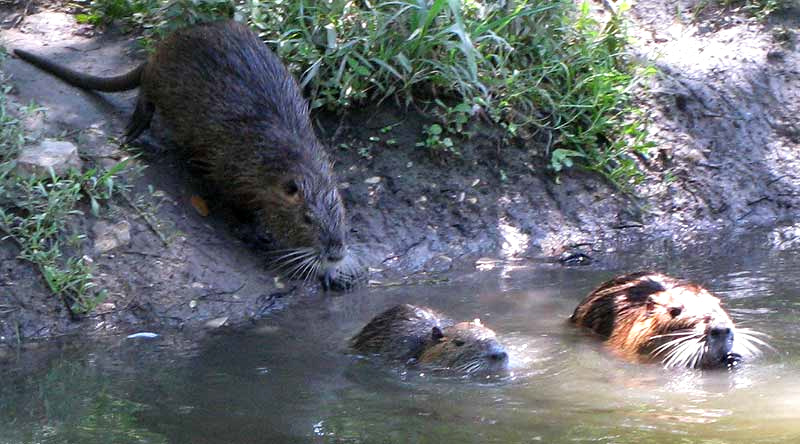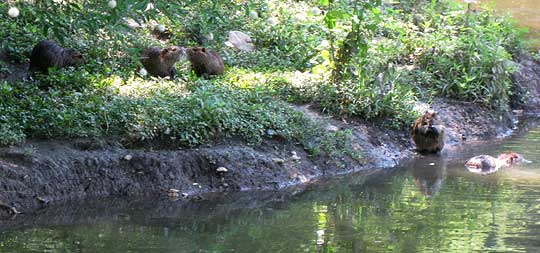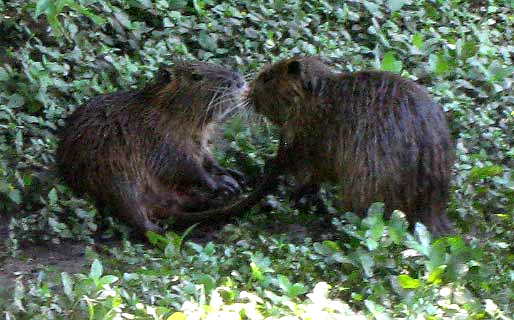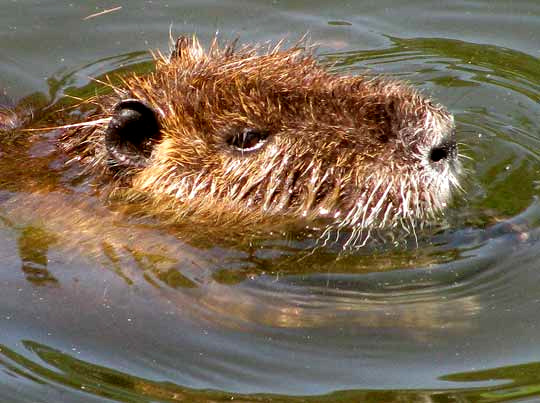Excerpts from Jim Conrad's
Naturalist Newsletter

from the June 8, 2014 Newsletter issued from the Frio Canyon Nature Education Center in the valley of the Dry Frio River in northern Uvalde County, southwestern Texas, on the southern border of the Edwards Plateau; elevation ~1750m (~5750 ft); N29.62°, W99.86°; USA
NUTRIA
The small, intermittently flowing, sometimes almost non-existent Leona River runs through Uvalde's Memorial Park, where it's been widened into a small lake with a pleasant, mostly shaded walkway encircling it. From a small island in that lake a high-pitched, mammalian squeal made me look that way, where I saw the busy family scene shown below:

The squealing came from two immature critters tussling with one another among the island's weeds while a sibling looked on from the picture's far left. At the water's edge the fourth juvenile reared on its haunches like a squirrel gnawing an acorn, while in the water a much larger adult floated in a patch of sunlight, emitting circles of little waves from its plant-chewing jaws.
Too small to be Beavers, at first I thought they might be Muskrats but, really, they were too large for that. The camera zoomed in on the brawling squealers revealing that their tails were round in cross-section, not flattened like a Beaver's, as you can see below:

The tail is shown in a more normal position, and at the top of this page you can see how much smaller and darker the youngsters are than the adult. The rounded tail is more proof that we didn't have Muskrats, because Muskrat tails are flattened, used to help propel the Muskrat's body through water, like a flattened fish's tail. When this animal swam, the tail seemed to just go along for the ride.
Finally I remembered hearing that the Leona has been invaded by Nutria, and that's what we have: Nutria also are called Coypu after the Spanish Coipú, as well as River Rat, Swamp Rat and other names. They're MYOCASTOR COYPUS, originally native to subtropical and temperate South America, but now introduced into North America, Europe, Asia and Africa, mainly by fur ranchers. When you see how coarse their hair is you wonder how valuable the fur would be. A close-up showing a feeding adult's coarse hair is shown below:

However, as with many mammals, Nutrias produce various hair types. The unkempt spikiness shown by the adult in the picture is produced by "guard hairs." Below those there's an "underfur" regarded as very soft and plush, and often is used for linings and trims, and frequently dyed various colors.
In Louisiana the Nutria's ecological effect on coastal wetlands has been disastrous, resulting in an expensive Nutria Control Program conducted by The Louisiana Department of Wildlife and Fisheries. That agency produces an informative and interesting website dealing with Nutria history, wetland damage and biology at the Nutria.com website.
Nutria were intentionally introduced into Texas to control undesirable vegetation such as Waterhyacinth, and to give trappers something to trap. Now they're on Texas's list of top ten invasive species, right between fire ants and feral hogs. Next to their picture you read, "These pesky rodents feed on planted seedlings and saplings, and have consequently denuded hundreds of thousands of acres of marshlands and floodplains along the Gulf Coast. Efforts to regenerate destroyed regions have been futile, as nutria have been observed to decimate replanted vegetation even further."
An individual Nutria eats about one quarter of its body weight daily, feeds year-round, and because it prefers feeding on stems of aquatic plants, leaving leaves and shoots behind, it may waste 90% of the plant it eats.
So, one has mixed feelings about the Nutria family so easily observably on the island in Uvalde's city park. On the one hand, they're fascinating and fun to watch, but, on the other, it's worrisome to think what damage they and their descendents might inflict on the local environment.